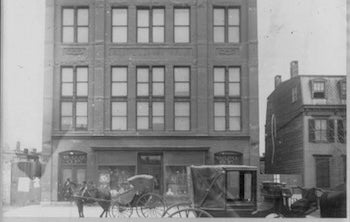We’ve been banking Black!
Recently there’s been a renewed interest in Black banking. As African-Americans continue to fight against oppression from all sides, upward economic mobility remains a chief priority as Black families aim to avoid the pitfalls of predatory loans, racist banking practices and the wars to come.
In September 2020, Brian E. Argrett, CEO of City First Bank in Washington, D.C. and Wayne-Kent A. Bradshaw, CEO of the publicly traded Broadway Financial Corp (BYFC) in Los Angeles, merged to create the largest Black-Owned bank in the nation with more than $1 billion combined assets.
With Argrett serving as CEO and Bradshaw as chairman, their goal is to increase their lending capacity for commercial investments with a focus on affordable housing, small businesses, and nonprofit development in underserved areas.
“We need to scale up our impact,” Argrett said in a New York Times interview. “Having a larger capital base is important so we can direct more resources into underserved communities…In the midst of a global pandemic, unprecedented unemployment, and the very important social unrest going on in our country, C.D.F.I.s are the answer…By building a bicoastal and national platform, we have the opportunity to become a very attractive platform for impact investors looking to join this space,” he added.
In May of 2022, we saw a similar focus when Minnesota welcomed its first-ever Black-owned bank, First Independence. The bank was a community effort, Detroit’s First Independence seeking out Minnesota for their next location because of its dense Black community and the issues of wealth disparity among Black residents. Prior to launch, they received support from several community organizations and other banking institutions, with Wells Fargo donating a building space. This month, the company succeeded in opening its second Minnesota location.
“It’s really, really important to understand that to close the racial wealth gap, it’s going to take all of us. It’s not a one-bank solution, it’s not a five-bank solution, heck, it’s not a 20-bank solution. So we all need to work together to help institutions like First Independence grow and succeed and thrive. There’s enough business to go around,” said Danielle Squires, head of diverse segments for corporate investment and banking at Wells Fargo.
Like many things in this country, banking institutions also need diversity in ownership and staffing in order to ensure marginalized communities receive fair and equitable financial services and opportunities. However, while Black-owned banks like First Independence and Greenwood are on the rise today, there was a time when they were plentiful. In fact, the first Black-owned and operated bank, Capital Savings Bank of Washington, D.C., was recorded as opening more than 130 years ago.
According to the African American Registry, the first bank for Blacks, Capital Savings Bank of Washington, D.C., opened on October 17, 1888. Despite segregation and Jim Crow, Black families were beginning to thrive economically, recognizing financial stability as a viable means for equality. As a result, Black entrepreneurs sprouted up all over the country and the founding of Black banks increased, ensuring that the Black community received equal access to capital and fair lending practices.
Capital Savings Bank was the first, reporting deposits of more than $300,000 by 1892. The bank provided the money essential to the growth of Black businesses, money white banks refused to lend. According to the Partnership for Progress, during the panic of 1893, a time of economic depression, it was Capital Savings that was able to withstand the struggle, meeting every customer’s obligation. The Free African Society, Free Labor Bank, and the Freedman’s Savings and Trust Company were all organizations that laid the framework for Black capitalism, Capital Savings materializing that framework into a physical location where Blacks could not only participate in banking, but also learn key financial tools critical to economic stability.
At Capital Savings, they opened their doors to all classes of bankers, teaching customers about employment, saving, and homeownership. Many Black churches and fraternal organizations worked together to pool the money needed to open Black banks like Capital Savings that would be sensitive to the needs of the African-American community. Between 1888 and 1934, there were 134 Black-owned banks established, with the number of Black-owned businesses skyrocketing between 1867 to 1917 from 4,000 to 50,000. These banks played a critical role in helping to launch Black-owned businesses, small and large. While Black entrepreneurship and ingenuity have always been important, Black-owned banks have served as the crux of Black society, helping to bring those dreams to fruition and ensuring a strong and economically thriving Black community was possible. May we all remember and return.
Here’s what you need to know about the first Black bank. Photo Courtesy of Partnership for Progress.

